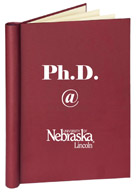Graduate Studies
First Advisor
Paul R. Hanson
Degree Name
Doctor of Philosophy (Ph.D.)
Committee Members
David Wishart, Rebecca Buller, Sherilyn Fritz
Department
Geography
Date of this Version
2025
Document Type
Dissertation
Citation
A dissertation presented to the Graduate College of the University of Nebraska in partial fulfillment of requirements for the degree of Doctor of Philosophy
Major: Geography
Under the supervision of Professor Paul R. Hanson
Lincoln, Nebraska, August 2025
Abstract
This dissertation explores the spatiotemporal signatures of fire in North American grassland ecosystems. In three chapters, I explore different aspects of fire history in the northern Great Plains. Chapter 1 is an introduction. Chapter 2 focuses on the Euro-American Settlement Period (ca. 1850–1950 C.E.). Fire histories from six different lakes in the Nebraska Sandhills are compared with two periods of historic drought and the establishment of United States Post Offices. Five of the six records show increased levels of biomass burning during the initial phases of Euro-American Settlement. Chapter 3 is a long-term (ca. 15,000 years), high-resolution fire history and paleoecological reconstruction from Dewey Marsh in the north-central Nebraska Sandhills. Charcoal counts, grain size and organic content analysis reveals temporal trends in landscape disturbance around the marsh, primarily occurring when the adjoining dunes were mobilized during prolonged droughts. Charcoal was deposited on the surrounding dunes during wetter periods and was blown into the marsh during sand dune mobilization. Chapter 4 is a fire history reconstruction from Blyburg Lake, located on the floodplain of the Missouri River in northeastern Nebraska. The Blyburg Lake fire record is compared with trends in grain size analysis and reveals connections of fire occurrence with changes in silt and sand flux, both proxies for flooding on the Missouri River. Unstable winter conditions and increased flooding in the Upper Missouri basin are correlated with increased charcoal deposition in Blyburg Lake. Chapter 5 concludes the work of this dissertation. These chapters illustrate how charcoal accumulates in three different environmental settings and during different time periods over the last ~15,000 years. Knowing more about how fire fluctuates during changing environmental conditions will help inform a concise knowledge of the ecological operating range for future climatic changes in the northern Great Plains.
Advisor: Paul R. Hanson
Recommended Citation
Benes, James Victor, "Fire History, Ecological History, and Historical Human-Environment Interactions in the Northern Great Plains" (2025). Dissertations and Doctoral Documents from University of Nebraska-Lincoln, 2023–. 341.
https://digitalcommons.unl.edu/dissunl/341
Included in
Biological and Physical Anthropology Commons, Ecology and Evolutionary Biology Commons, Emergency and Disaster Management Commons, Environmental Health and Protection Commons, Environmental Policy Commons, Environmental Studies Commons, Human Ecology Commons, Nature and Society Relations Commons



Comments
Copyright 2025, James Victor Benes. Used by permission